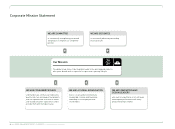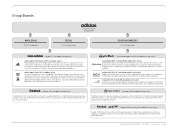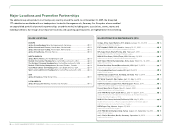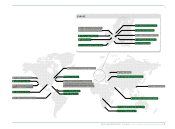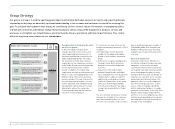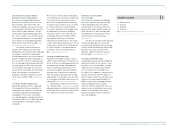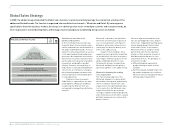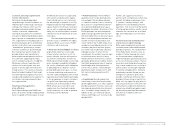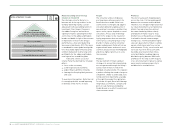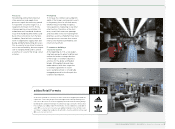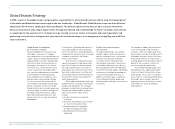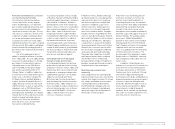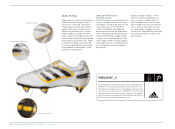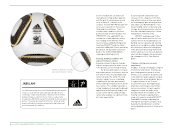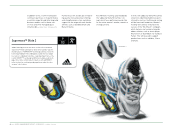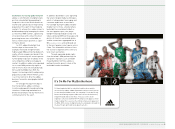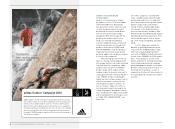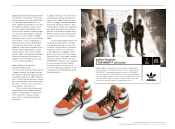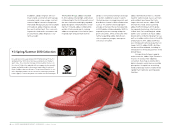Reebok 2009 Annual Report Download - page 62
Download and view the complete annual report
Please find page 62 of the 2009 Reebok annual report below. You can navigate through the pages in the report by either clicking on the pages listed below, or by using the keyword search tool below to find specific information within the annual report.
58 GROUP MANAGEMENT REPORT – OUR GROUP Global Brands Strategy
Global Brands Strategy
In 2009, as part of the adidas Group’s reorganisation, responsibility for all marketing functions and the long-term development
of the adidas and Reebok brands was brought under one leadership – Global Brands. Global Brands comprises three divisions:
adidas Sport Performance, adidas Sport Style and Reebok. The primary objective of the new set-up is to ensure these three
divisions seize market and category opportunities through well-defined and coordinated go-to-market strategies. Each division
is responsible for the execution of its strategic focus by creating a constant stream of innovative and inspiring products and
generating communication strategies that represent each brand and category in an engaging and compelling way with their
target consumers.
Global Brands to strengthen
go-to-market strategies
We acknowledge that to be successful
with today’s consumer, a strategy of
mass production or mass marketing is no
longer sufficient. Only by identifying and
understanding consumers’ buying habits,
their fitness level, their motivations for
doing sport, their goals for the season
or the next race, or even the next party,
can we create more meaningful prod-
ucts, services and experiences that build
a lasting impression beyond product,
price and promotion. In addition, as we
operate under a multi-brand strategy,
it is also essential that our brands act
concertedly to fully exploit market oppor-
tunities. Therefore, in 2009, the Global
Brands function was formed to guide and
reinforce the go-to-market strategies for
the adidas Sport Performance, adidas
Sport Style and Reebok divisions with
a particular focus on long-term brand
development.
To achieve this, Global Brands defines a
clear target audience and value propos-
ition for each division, and subsequently
coordinates the execution of go-to- market
strategies to maximise the Group’s
impact in the market.
Each division is separately respon-
sible for bringing its respective position-
ing to life, through the creation of prod-
ucts and communication tools that not
only support the commercial functions in
their day-to-day business activities, but
also provide the platform and framework
for long-term market share and profit-
ability improvements.
While adidas and Reebok each have
unique identities, heritages, technologies,
designs and reputations, the strategic
principles and methods for driving future
sales growth and profit ability improve-
ments are common to both. These
include:
Product innovation to inspire the
consumer.
Activation and validation via a relevant
set of promotion partnerships.
Extend brand reach and appeal
through strategic partnerships.
Marketing and communication
leadership.
Product innovation to inspire
the consumer
Through Global Brands, we are deter-
mined to address every consumer in a
specific and unique way – with product
initiatives that generate trade and
consumer interest. We believe that
technological innovation is essential to
sustainable leadership in our industry.
By leveraging the extensive R&D exper-
tise within the Group, adidas and Reebok
continuously challenge the boundaries
of functionality and performance. In
addition, innovation plays a significant
role in differentiating the adidas and
Reebok product offerings in the minds of
consumers.
For example at adidas, personalisation
is one of the brand’s lead innovation
concepts, and it is an adidas goal to be
the most personal sports brand by 2015.
At Reebok, innovation focus is on fitness
and training, where a current priority is
creating products that provide a material
benefit to the consumer in terms of
muscle toning and conditioning.
By creating inspiring product and
brand experiences, adidas and Reebok
strive to enhance their positions as pre-
mium brands. This, in turn, is an impor-
tant catalyst to sustaining and improving
the brands’ gross margins, therefore
making continuous innova
tion an impor-
tant enabler for future
profitability
improvements.


